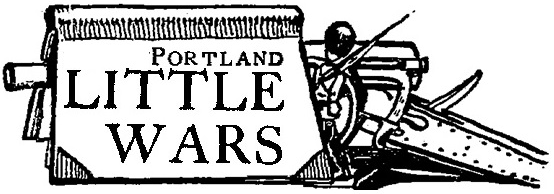A quick note: there's three things I'm looking for: (a) the colors of the tunic things the Gendarmes wear over/under/around their armor; (b) the color of the feathers/plumes on their helmets, and (c) colors and decorations on their horse armor.
In the below detail, the tunics are mostly rich yellow (saffron?) with some red ones as well. Helmet plumes are overwhelmingly white with some blue and yellow. Horse armor is not painted, painted flat red, or is blue or yellow with a lot of decorative detailing. Lances are all of plain wood.
In the next one below, tunics are again red or yellow. Plumes are red or white. Horse armor is is red, an ornate, decorative yellow/gold/brass, or a blue caparison with fleur-de-lis on it.
In this detail below, we see white plumes again, and a blue or green tunic with yellow trim (on the right) in addition to the usual red tunics. Horse armor is yellow/gold with a lot of detailing.
This next detail is from the bottom of the subject painting so you can't see the horse armor very well, but the fellow to the bottom right's horse has white armor with blue detailing. Otherwise red and yellow tunics are uniform with white and red plumes. Lances are all of plain wood.
Next up is the full-size painting identified by the web as the Battle of Issus (a battle of Alexander the great), but it clearly shows Imperialist heavy cavalry and infantry chasing off stradiot light cavalry and other pikemen. If you look in the middle where infantry are clashing you can see some doppelsoldners using their two-handed swords.
In the below detail from the 'Issus' painting is a ton of heavy cavalry. These are likely not French gendarmes but still the same patterns are present: white helmet plums and red tunics. Horse armor is mostly not colored but there some red and a very dark blue. Lances are all of plain wood.
The below detail is from the cavalry scrum in upper middle of the 'Issus' painting. Red and yellow tunics again. Unpainted horse armor.
So, I've got 30 gendarmes that will make up five units of six figures each. I'm thinking the riders will mostly have yellow or red tunics, but a minority (maybe even only one figure out of each unit) will have 'royal blue' tunics. For plumes maybe 20 will be white, 10 red, and the rest a mix of white with yellow or blue.
Horse armor is the trickiest. Perhaps 6 with just metal armor with no paint. There are few which have cloth caparisons so those will be red or yellow with patterns or decoration. Then I'm thinking I'll pull six and do those in blue or white, all with decorations. That should leave 12-15 remaining and those will be just red or yellow with no decoration.
[EDIT - WANTED TO ADD A FEW MORE PAINTING I FORGOT ABOUT]
Below is a painting of Louis XII (king of France from 1498 to 1515, so most of the Italian Wars) riding out to do whatever with his Gendarmes. Being a king, his horse armor is of course very decorated. But his bodyguard mostly conform to the prior paintings: red or yellow horse armor, red or yellow tunics, white plumes with some variation (purple!).
Neither of these paintings of Louis XII are going to change the color scheme for my Gendarmes, but I wanted to share that perhaps kings, nobles, and royal guards and the such might have used more elaborate tunics and horse armor.
















